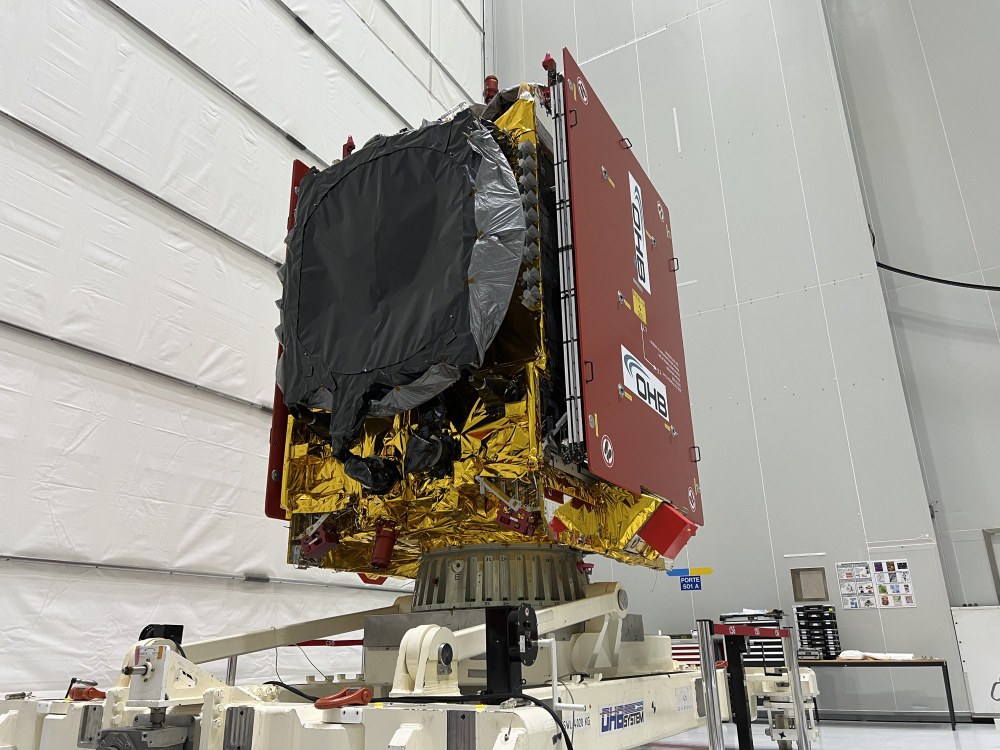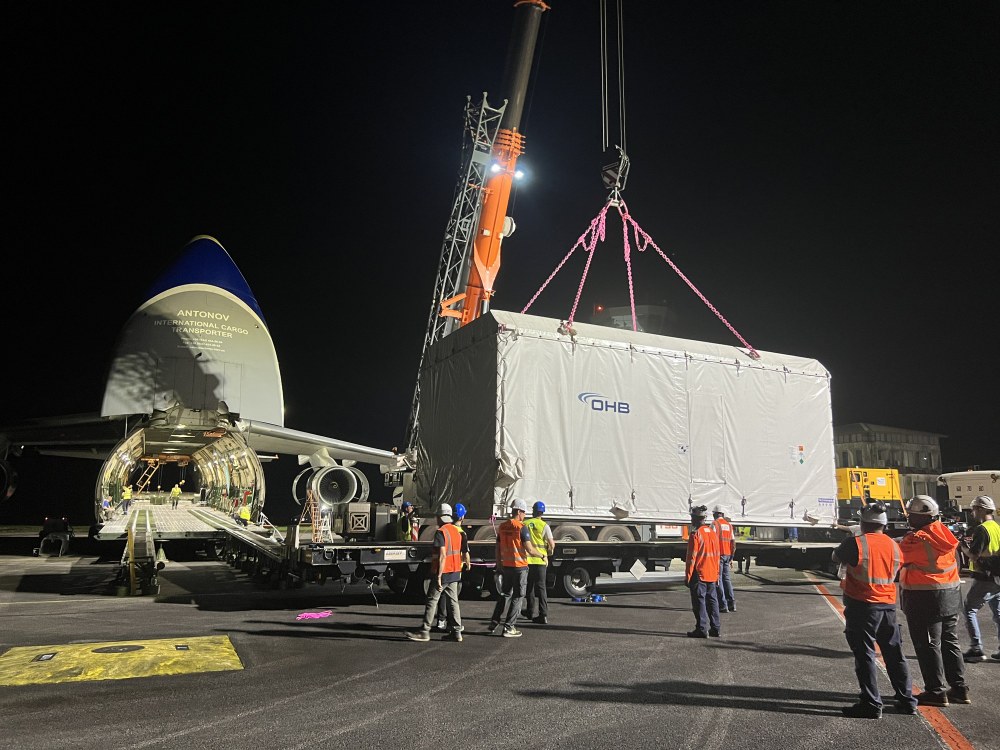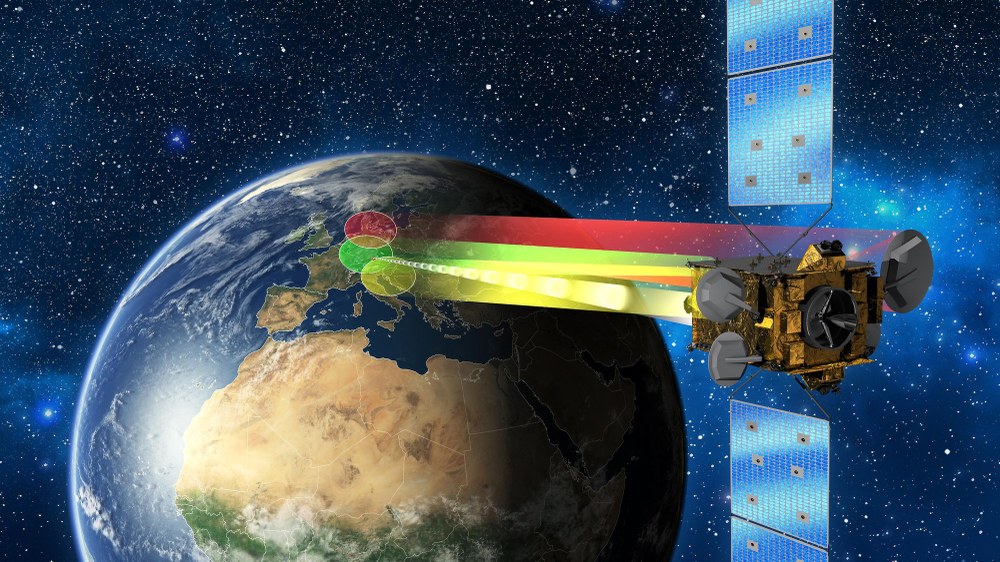Heinrich Hertz mission ready for launch


- Germany’s Heinrich Hertz communications satellite is scheduled to lift off on 16 June 2023 aboard the last Ariane 5 launch vehicle.
- The Heinrich Hertz mission is managed by the German Space Agency at DLR in Bonn on behalf of the German Federal Ministry for Economic Affairs and Climate Action (BMWK) and with the participation of the German Federal Ministry of Defence (BMVg).
- New technologies will be tested in space under real operating conditions. Additional experiments will be conducted on communications, and antenna and satellite technologies. The mission is planned to last 15 years.
- Focus: Space, satellite communications
As global communications bandwidth needs rapidly increase, so do the demands on communications satellites. Communications satellites capable of handling modern and future demands must therefore make use of much more high-performance technologies than previous generations. With the ‘Heinrich Hertz’ mission, the German Space Agency at the German Aerospace Center (Deutsches Zentrum für Luft- und Raumfahrt; DLR) will launch its own national communications satellite on 16 June 2023. After an absence of more than 20 years, the satellite will comprehensively demonstrate German system capabilities in this field. The technologies on board are designed to respond in a smart and flexible manner to future challenges in the field of satellite communications and to be able to support future communications scenarios. The 3450-kilogram, van-sized satellite will begin its journey into space as one of two payloads on the last-ever European Ariane 5 launch vehicle (type ECA) from the European spaceport in Kourou, French Guiana. This will be the 117th launch of the Ariane 5.
The satellite will enable experiments on communications, and antenna and satellite technologies developed and built by German research institutes and companies, that will validate these technologies for use in space or test them under real operating conditions for the first time. With the fuelling of the satellite at the Centre Spatial Guyanais (CSG) on 19 to 24 May 2023, the mission is now a significant step closer to launch. Following its launch, the satellite will orbit Earth at an altitude of approximately 36,000 kilometres in a geostationary orbit – it will always be above the same point on Earth’s surface – for 15 years.

Video: The journey from Germany to South America for the German satellite Heinrich Hertz (in German)
Your consent to the storage of data ('cookies') is required for the playback of this video on Youtube.com. You can view and change your current data storage settings at any time under privacy.
"The Hamburg physicist Heinrich Hertz was a pioneer in communications and media technology. Without him, mobile phones, television and the internet would be unthinkable today. The Heinrich Hertz mission is also doing pioneering work. We are sending an intelligent satellite into space that can process information independently on board. Its systems can then be flexibly adapted to new technical requirements and market conditions by teams on Earth. In a figurative sense, this smart satellite will grow with its tasks while in orbit," emphasises Walther Pelzer, DLR Executive Board Member and Director General of the German Space Agency at DLR. The strength of the communication signal and the communication bandwidth can be adjusted in orbit. Its digitally scalable communication bandwidths cover broadband to narrowband applications and enable Heinrich Hertz to be flexibly adapted to new communication standards.
Communication reimagined
Receiving and forwarding data – that is a limitation of the normal mode of operation of a communications satellite. But would it not be much more practical if the incoming information could already be filtered and processed on board the satellite? This is role of the additional miniaturised computer systems installed on Heinrich Hertz. These on-board processors are a new type of computer that can interpret the signals received by the satellite, regenerate them and send them back to Earth. These processors are powerful and enable digital signal processing on board satellites. They are also flexibly reprogrammable. “Heinrich Hertz’s long, 15-year mission will see the satellite’s capabilities be continuously adapted to ever-changing technical requirements. These processors make the mission a very flexible tool that researchers will also use to investigate questions of the future in orbit,” explains Heiko Ultes, Project Manager of the Heinrich Hertz mission at the German Space Agency at DLR.
Sustainably powered by electricity
For a satellite to reach its intended orbit, its launch vehicle must first overcome gravity and it must accelerate to the desired orbital velocity. Chemical thrusters offer high thrust and provide the necessary acceleration to reach orbit. They carry the launcher and satellite into approximately the desired orbit. Once there, the orbit and orientation of the satellite in the vacuum of space can be controlled much more effectively and, above all, more precisely with electric thrusters rather than with chemical ones. Electric propulsion systems can reduce weight, and thus save costs, and increase the overall propellant content and thus the satellite’s operating time or payload capacity. This is because the ionisation of the gaseous propellant can generate a significantly higher specific impulse than chemical propulsion systems. The electrically powered High Efficiency Multi Stage Plasma (HEMP) thruster, which powers the course corrections within the target orbit of the Heinrich Hertz mission, has a specific impulse five times higher than the best chemical thrusters.

Video: A small van in space – the Heinrich Hertz satellite mission
Your consent to the storage of data ('cookies') is required for the playback of this video on Youtube.com. You can view and change your current data storage settings at any time under privacy.
The Heinrich Hertz Mission and its partners
The Heinrich Hertz mission marks the first launch of a dedicated German communications satellite for researching and testing new technologies and communications scenarios. The mission will thus make an important contribution to Germany’s information society. The Heinrich Hertz mission is being led by the German Space Agency at the German Aerospace Center (Deutsches Zentrum für Luft- und Raumfahrt; DLR) in Bonn on behalf of the Federal Ministry for Economic Affairs and Climate Action (Bundesministerium für Wirtschaft und Klimaschutz; BMWK) and with the participation of the Federal Ministry of Defence (Bundesministerium der Verteidigung; BMVg). OHB-System AG was contracted to develop and build the satellite. The companies IABG GmbH, MDA AG and TESAT GmbH & Co. KG are also involved in the development and testing of the satellite. OHB Digital Connect is responsible for the ground segment in collaboration with CGI. The satellite control centre is located in Bonn. The locations for the mission’s new ground stations are in Hürth (North Rhine-Westphalia) and Neustrelitz (Mecklenburg-Western Pomerania). Arianespace is responsible for launching the mission on board an Ariane 5 launch vehicle (VA261). A total of 42 partners are involved in the mission, of which 14 are involved in the scientific payload.
Related link
- Video footage of the Heinrich Hertz mission

